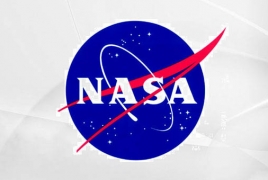Astronomers discover closest Earth-twin yet July 24, 2015 - 11:23 AMT PanARMENIAN.Net - Astronomers hunting for another Earth have found the closest match yet, a potentially rocky planet circling its star at the same distance as our home orbits the Sun, NASA said Thursday, July 23, according to AFP. Named Kepler 452b, the planet is about 60 percent larger than Earth. It could have active volcanoes, oceans, sunshine like ours, twice as much gravity and a year that lasts 385 days, scientists said. "Today we are announcing the discovery of an exoplanet that, as far we can tell, is a pretty good close cousin to the Earth and our Sun," said John Grunsfeld, associate administrator for NASA's Science Mission Directorate in Washington. NASA has made a handful of such announcements in the past, but each of those discoveries fell short of being Earth-like in one way or another, such as being too hot to host life or having a surface that was likely gaseous rather than hard and rocky, AFP notes. "This is about the closest so far," Grunsfeld added, describing Kepler 452b as our "closest twin," or "Earth 2.0." The planet was detected by the US space agency's Kepler Space Telescope, which has been hunting for other worlds like ours since 2009. This planet sits squarely in the Goldilocks zone of its star, where life could exist because it is neither too hot nor too cold to support liquid water, the US space agency said. Kepler 452b's star is 1.5 billion years older, four percent more massive and 10 percent brighter than our Sun. But at a distance of 1,400 light-years away, humankind has little hope of reaching this Earth-twin any time soon. If the planet is rocky -- and scientists believe that it has a better-than-even chance of being just that -- then it could be headed for a fearful scenario, as the heat from its dying star evaporates Kepler 452b's lakes and oceans. "Its location vis-a-vis its star could mean that it is just entering a runaway greenhouse phase of its climate history," said Doug Caldwell, a SETI Institute scientist working on the Kepler mission. "The increasing energy from its aging sun might be heating the surface and evaporating any oceans. The water vapor would be lost from the planet forever," he added. "Kepler 452b could be experiencing now what the Earth will undergo more than a billion years from now, as the Sun ages and grows brighter." Jenkins was more optimistic, however, based on the planet's age, size, and higher mass and gravity than on Earth. "This planet is protected at least for a little while longer, 500 million years or so, from experiencing the runaway greenhouse (effect), assuming that it is six billion years old," he told reporters. Related links: Azerbaijani authorities report that they have already resettled 3,000 people in the Nagorno-Karabakh town of Stepanakert. On June 10, Azerbaijani President of Azerbaijan Ilham Aliyev will leave for Turkey on a working visit. Azerbaijani President Ilham Aliyev arrived in Moscow on April 22 to hold talks with Russian counterpart Vladimir Putin. Authorities said a total of 192 Azerbaijani troops were killed and 511 were wounded during Azerbaijan’s offensive. Partner news |